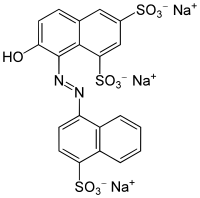Ponceau 4R
 |
|
| Names | |
|---|---|
|
IUPAC name
trisodium (8Z)-7-oxo-8-[(4-sulfonatonaphthalen-1-yl)hydrazinylidene]naphthalene-1,3-disulfonate
|
|
| Identifiers | |
|
2611-82-7 |
|
| 3D model (Jmol) | Interactive image |
| ChemSpider |
11232342 |
| ECHA InfoCard | 100.018.216 |
| E number | E124 (colours) |
| PubChem | 9570119 |
|
|
|
|
| Properties | |
| C20H11N2Na3O10S3 | |
| Molar mass | 604.46 g·mol−1 |
| Hazards | |
| NFPA 704 | |
|
Except where otherwise noted, data are given for materials in their standard state (at 25 °C [77 °F], 100 kPa).
|
|
|
|
|
| Infobox references | |
Ponceau 4R (known by more than 100 synonyms, including as C.I. 16255,Cochineal Red A,C.I. Acid Red 18,Brilliant Scarlet 3R,Brilliant Scarlet 4R,New Coccine, is a synthetic colourant that may be used as a food colouring. It is denoted by E Number E124. Its chemical name is 1-(4-sulpho-1-napthylazo)- 2-napthol- 6,8-disulphonic acid, trisodium salt. Ponceau (French for "poppy-coloured") is the generic name for a family of azo dyes.
Ponceau 4R is a strawberry red azo dye which can be used in a variety of food products, and is usually synthesized from aromatic hydrocarbons; it is stable to light, heat, and acid but fades in the presence of ascorbic acid.
It is used in Europe, Asia and Australia, but has not been approved by the US FDA.
There is no evidence of carcinogenicity, genotoxicity, neurotoxicity, or reproductive and developmental toxicity at the permitted dietary exposures; the European acceptable daily intake (ADI) is 0.7 mg/kg and the WHO/FAO ADI is 4 mg/kg.
The production process may result in unsulphonated aromatic amines present in concentrations of up to 100 mg/kg which may be linked to cancer. The lake pigment form of the colour additive can also increase the intake of aluminium beyond the tolerable weekly intake (TWI) of 1 mg/kg/week. Therefore, the limit for aluminium may be adjusted to accommodate for this.
Since the 1970s and the well-publicized advocacy of Benjamin Feingold, there has been public concern that food colourings may cause ADHD-like behavior in children. These concerns have led the FDA and other food safety authorities to regularly review the scientific literature, and led the UK FSA to commission a study by researchers at Southampton University of the effect of a mixture of six food dyes (Tartrazine, Allura Red AC, Ponceau 4R, Quinoline Yellow WS, Sunset Yellow and Carmoisine (dubbed the "Southampton 6")) and sodium benzoate (a preservative) on children in the general population, who consumed them in beverages; the study published in 2007. The study found "a possible link between the consumption of these artificial colours and a sodium benzoate preservative and increased hyperactivity" in the children; the advisory committee to the FSA that evaluated the study also determined that because of study limitations, the results could not be extrapolated to the general population, and further testing was recommended".
...
Wikipedia

